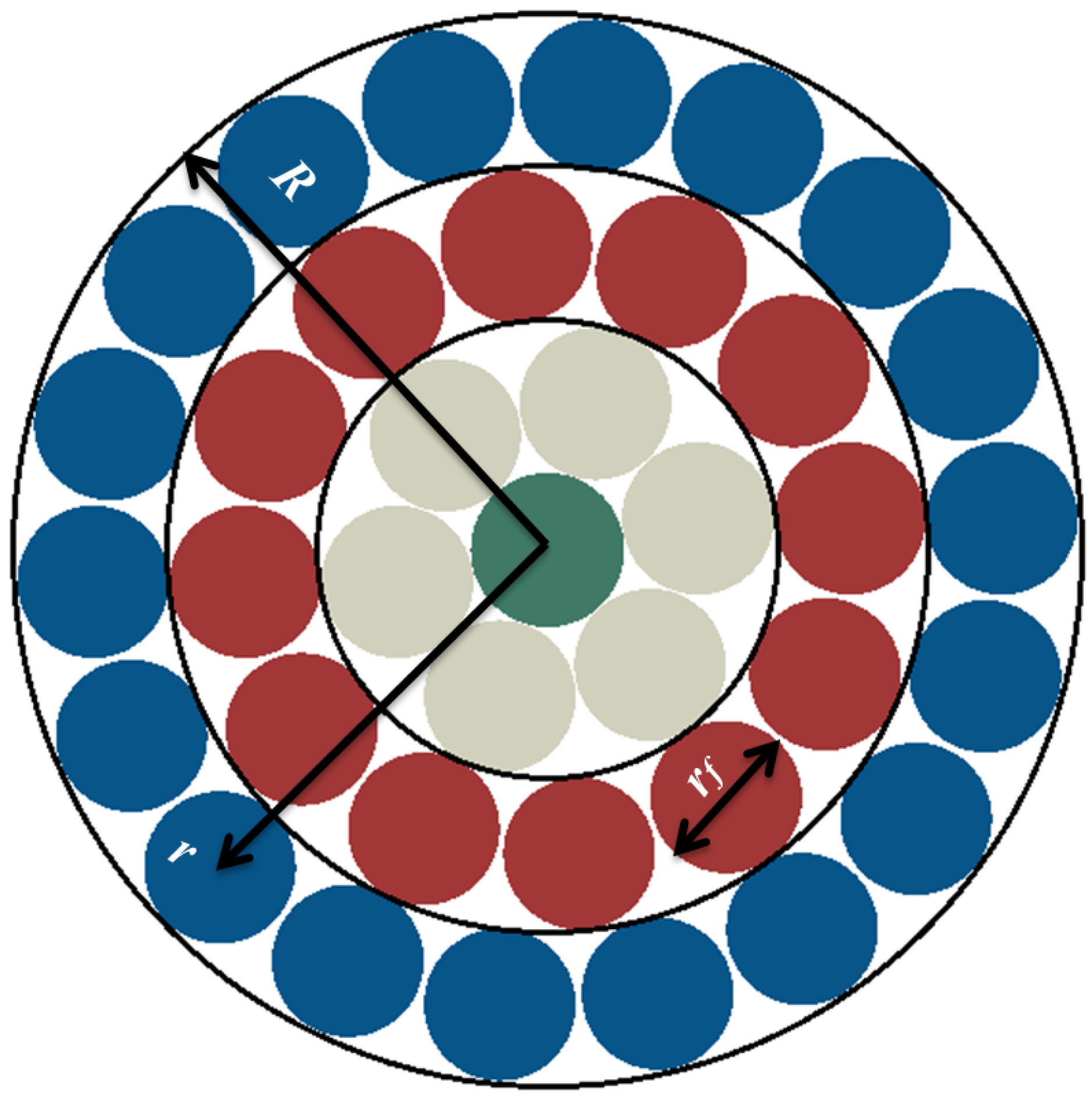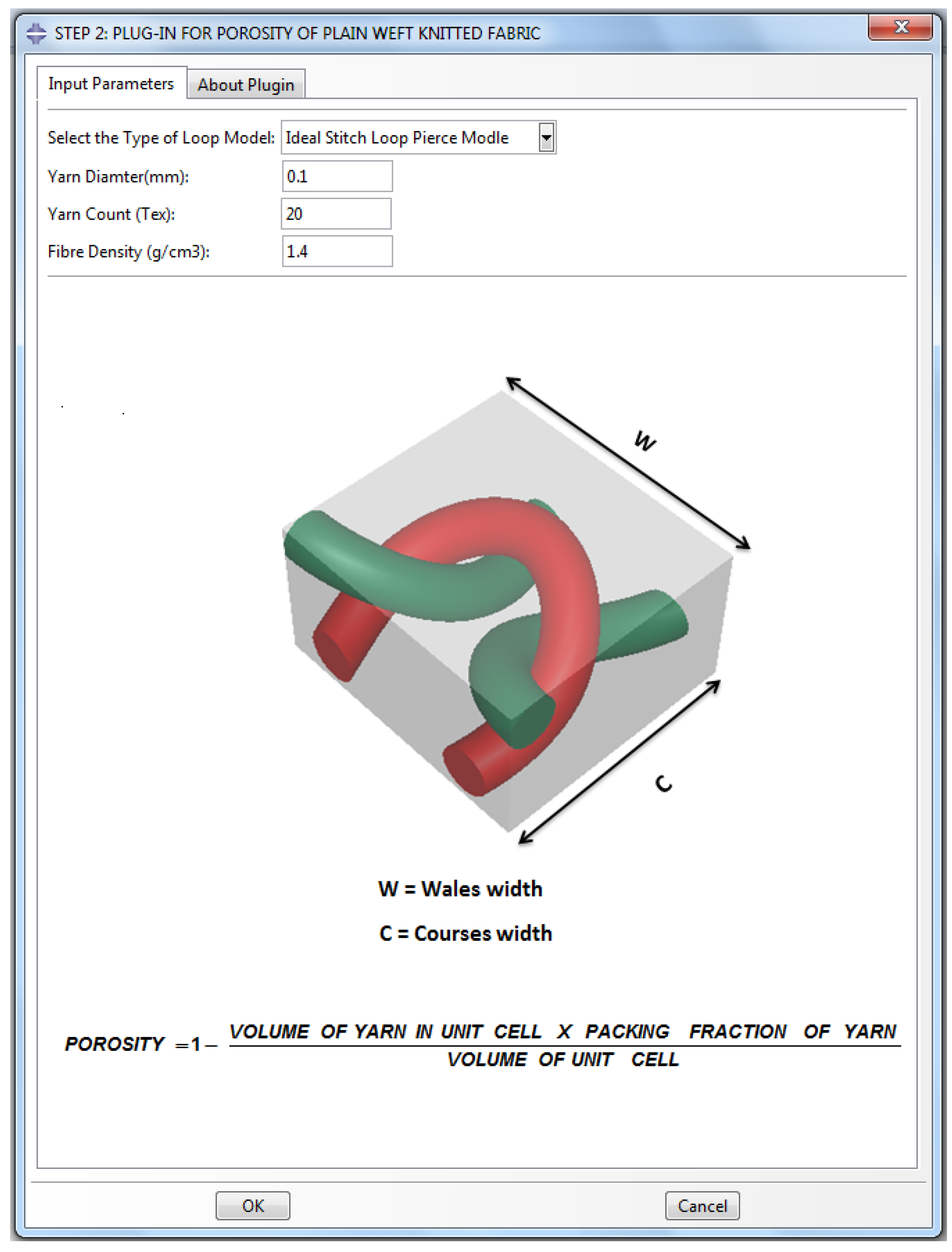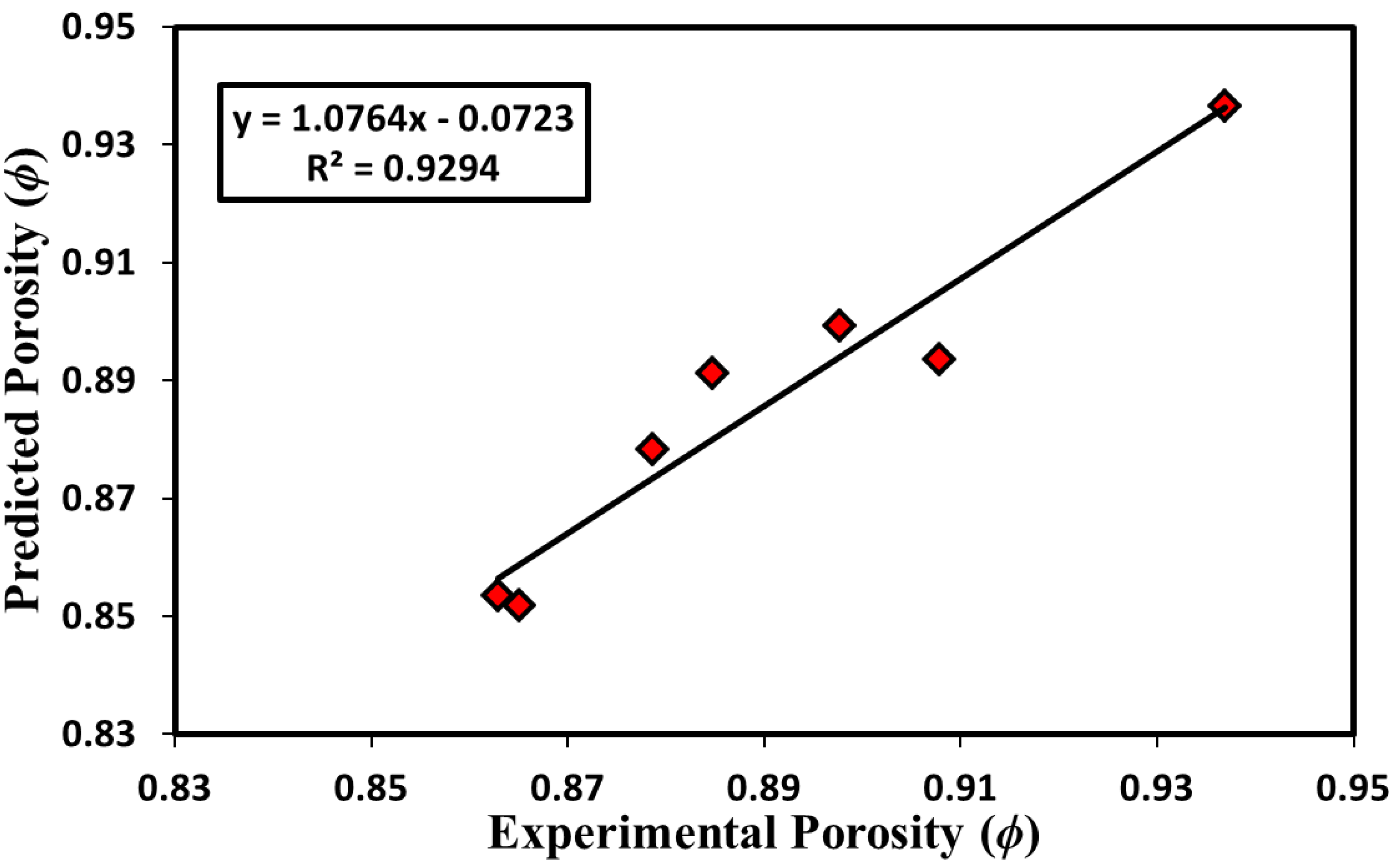Porosity Prediction of Plain Weft Knitted Fabrics
Abstract
:1. Introduction
2. Materials and Methods
| Fabric code | F1 [5] | F2 [5] | F3 [5] | F4 [5] | F5 | F6 | F7 |
|---|---|---|---|---|---|---|---|
| Fiber type | Cotton | Polyester | Polyester | ||||
| Yarn type | Staple Fiber | Monofilament | Multifilament | ||||
| Yarn count (Tex) | 24.61 | 24.61 | 24.61 | 24.61 | 27.00 | 27.00 | 19.0 |
| Yarn radius (mm) | 0.129 | 0.130 | 0.134 | 0.132 | 0.0785 | 0.0785 | 0.16 |
| Wales per cm | 9.00 | 9.00 | 9.00 | 9.00 | 5.40 | 5.40 | 6.40 |
| Courses per cm | 8.00 | 9.00 | 11.0 | 13.0 | 10.6 | 11.8 | 10.6 |
| Stitch length (mm) | 5.137 | 4.916 | 4.53 | 4.119 | 4.725 | 4.6896 | 5.000 |
| Fabric thickness (mm) | 0.52 | 0.53 | 0.53 | 0.56 | 0.512 | 0.507 | 0.72 |
| Areal density (g/m2) | 86.0 | 98.0 | 118.0 | 126.0 | 71.67 | 75.0 | 63.4 |
| Fiber density (g/cm3) | 1.52 | 1.52 | 1.52 | 1.52 | 1.39 | 1.39 | 1.39 |
2.1. Plug-in
- (1)
- 3D geometrical model creation of plain weft knitted fabric;
- (2)
- Porosity calculation.

2.2. 3D Model


2.3. Plug-in for Multifilament Weft Knitted Fabric


2.4. Prediction of Porosity


3. Results and Discussion
| Fabric code | Plug-in predicted | Experiment |
|---|---|---|
| F1 | 0.8848 | 0.8912 |
| F2 | 0.8787 | 0.8783 |
| F3 | 0.8629 | 0.8535 |
| F4 | 0.86502 | 0.8519 |
| F5 | 0.8977 | 0.8993 |
| F6 | 0.90788 | 0.8936 |
| F7 | 0.93691 | 0.9366 |


4. Conclusions
Acknowledgments
Author Contributions
Conflicts of Interest
References
- Guidoin, R.; King, M.; Marceau, D.; Cardou, A.; de la Faye, D.; Legendre, J.M.; Blais, P. Textile arterial prostheses: Is water permeability equivalent to porosity? J. Biomed. Mater. Res. 1987, 21, 65–87. [Google Scholar] [CrossRef] [PubMed]
- Benltoufa, S.; Fayala, F.; Cheikhrouhou, M.; Nasrallah, S.B. Porosity determination of jersey structure. Autex Res. J. 2007, 7, 63–69. [Google Scholar]
- Ogulata, R.T.; Mavruz, S. Investigation of porosity and air permeability values of plain knitted fabrics. Fibres Text. East. Eur. 2010, 18, 71–75. [Google Scholar]
- Angelova, R.A. Determination of the pore size of woven structures through image analysis. Cent. Euro. J. Eng. 2012, 2, 129–135. [Google Scholar] [CrossRef]
- Karaguzel, B. Characterization and Role of Porosity in Knitted Fabrics. M.S. Thesis, North Carolina State University, Raleigh, NC, USA, 2004. [Google Scholar]
- Dias, T.; Delkumburewatte, G.B. The influence of moisture content on the thermal conductivity of a knitted structure. Measure. Sci. Tech. 2007, 18, 1304–1314. [Google Scholar] [CrossRef]
- Abdolmaleki, S.; Jeddi, A.A.A.; Amani, M. Estimation on the 3D porosity of plain knitted fabric under uniaxial extension. Fibers Polym. 2012, 13, 535–541. [Google Scholar] [CrossRef]
- Turan, R.B.; Okur, A.; Deveci, R.; Açikel, M. Predicting the intra-yarn porosity by image analysis method. Text. Res. J. 2012, 82, 1720–1728. [Google Scholar] [CrossRef]
- Delkumburewatte, G.B.; Dias, T. Porosity and capillarity of weft knitted spacer structures. Fibers Polym. 2009, 10, 226–230. [Google Scholar] [CrossRef]
- Peirce, F.T. Geometrical principles applicable to the design of functional fabrics. Text. Res. J. 1947, 17, 123–147. [Google Scholar] [CrossRef]
- Hurd, J.C.H.; Doyle, P.J. Fundamental aspects of the design of knitted fabrics. J. Text. Inst. Proc. 1953, 44, 561–578. [Google Scholar] [CrossRef]
- Shinn, W.E. An engineering approach to jersey fabric construction. Text. Res. J. 1955, 25, 270–277. [Google Scholar] [CrossRef]
- Leaf, G.A.V.; Glaskin, A. The geometry of a plain knitted loop. J. Text. Inst. Trans. 1955, 46, T587–T605. [Google Scholar] [CrossRef]
- Leaf, G.A.V. Models of the plain-knitted loop. J. Text. Inst. Trans. 1960, 51, T49–T58. [Google Scholar] [CrossRef]
- Munden, D.L. The geometry and dimensional properties of plain-knit fabrics. J. Text. Inst. Trans. 1959, 50, T448–T471. [Google Scholar] [CrossRef]
- Postle, R. Dimensional stability of plain-knitted fabrics. J. Text. Inst. 1968, 59, 65–77. [Google Scholar] [CrossRef]
- Kurbak, A. Plain knitted fabric dimensions (Part II). Text. Asia. 1998, 29, 36–44. [Google Scholar]
- Demiroz, A.; Dias, T. A study of the graphical representation of plain-knitted structures part I: Stitch model for the graphical representation of plain-knitted structures. J. Text. Inst. Trans. 2000, 91, 463–480. [Google Scholar] [CrossRef]
- Choi, K.F.; Lo, T.Y. An energy model of plain knitted fabric. Text. Res. J. 2003, 73, 739–748. [Google Scholar] [CrossRef]
- Li, Y.L.; Yang, L.H.; Chen, S.Y.; Yuan, J.; Li, N.N. 3D modeling and simulation of fancy fabrics in weft knitting. J. Donghua Uni. Engl. Ed. 2012, 29, 351–358. [Google Scholar]
- Siddiqui, M.O.R.; Sun, D. Automated model generation of knitted fabric for thermal conductivity prediction using finite element analysis and its applications in composites. J. Indust. Text. 2014. [Google Scholar] [CrossRef]
- TexGen software. Available online: http://www.texgen.sourceforge.net (accessed on 1 March 2012).
- TexEng Software Ltd. Available online: http://www.texeng.co.uk/ (accessed on 1 March 2012).
- WiseTex Software. Available online: https://www.mtm.kuleuven.be/Onderzoek/Composites/software/wisetex (accessed on 1 April 2013).
- Schwarz, E.R. Certain aspects of yarn structure. Text. Res. J. 1951, 21, 125–136. [Google Scholar] [CrossRef]
© 2014 by the authors; licensee MDPI, Basel, Switzerland. This article is an open access article distributed under the terms and conditions of the Creative Commons Attribution license (http://creativecommons.org/licenses/by/4.0/).
Share and Cite
Siddiqui, M.O.R.; Sun, D. Porosity Prediction of Plain Weft Knitted Fabrics. Fibers 2015, 3, 1-11. https://doi.org/10.3390/fib3010001
Siddiqui MOR, Sun D. Porosity Prediction of Plain Weft Knitted Fabrics. Fibers. 2015; 3(1):1-11. https://doi.org/10.3390/fib3010001
Chicago/Turabian StyleSiddiqui, Muhammad Owais Raza, and Danmei Sun. 2015. "Porosity Prediction of Plain Weft Knitted Fabrics" Fibers 3, no. 1: 1-11. https://doi.org/10.3390/fib3010001





